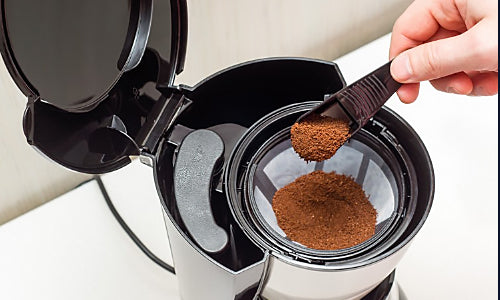Your Cart is Empty

Brewing your perfect cup of espresso is not the simplest process, but boy, is it worth it! The syrup body, the shiny crema, and the energy boost. What’s a better way to start your day? Maybe two stellar cups of espresso?
In this article, we’ll see how to brew a perfect cup of espresso. Below are seven tips for turning thatmeh cup of coffee into an Oh-My-God-this-is-AMAZING! cup. You definitely can’t ignore these suggestions if you’re brewing your espresso at home.
Here we go.
Your espresso beans are not to be placed in direct sunlight; they are instead suited for cool, dark areas. Think of Batman...
Storing espresso beans properly will keep the flavor and freshness longer. To go one step further, get an opaque vacuum container. A little overboard, but for those who want to go the extra mile, it's necessary.
Coffee beans have to be kept dry too. Exposing your beans to moisture kick-starts the extraction process when you’re clearly not ready for that. This explains why you can’t differentiate some cups of espresso from line water. We highly recommend airtight containers.
Your espresso needs cleaning from time to time. You can do so easily and quickly by pouring in some hot water. Cleaning your machine removes all remnants of coffee grounds grounded in the dungeon and will also minimize the effects of leftover oils in the machine.
However, this simple procedure will not be enough after some time. You should deep clean for every 200 cups your machine makes. It is only natural that the machine is clogged up by some oils and grounds after a long while. You’ll need a good coffee cleaner for this purpose.
No two separate cups of coffee are cultivated, roasted, and produced alike — much courtesy to the difference in beans quality. There are various classes of beans to select from, and most aren’t good for espresso. That leaves you with only one option: always use fresh, good-quality coffee beans—one of theessential qualities of good espresso.
Just so you know, coffee beans don’t exactly come with a sticker screaming “Caught Unfresh Today.” So, what to do is keep an eye on the roasting date. Choose products that were roasted not more than ten days before. Truly, coffee beans don’t spoil, but they lose most of their flavor within 14-21 days after roasting.
When chasing thata-m-a-z-i-n-gcup of espresso, always opt for beans in the beans or grounds debate. The best flavors are obtained by buying whole beans (roasted less than ten days ago) and grinding right before you brew. Now, why the emphasis on proper grinding?
Well, the texture of your espresso is equally important. A “too fine” powder can only give an unpleasant, bitter taste, while a “too coarse” ground will allow water to seep through without completely extracting the flavor of your beans.
Painfully, it can be difficult to note the little difference between both bean textures, but trust that it affects flavor very clearly. Your fingers can hardly note the difference but wait for your tongue.
Thus, it is recommended to buy an espresso with a dedicated grinder that will allow you to make those micro-adjustments, which can make the entire difference in how your coffee tastes. Note that it takes a while to find the perfect setting, so experimentation is key.
Generally, the rule of thumb here is that 1 gram of coffee grounds gives you 2 millimeters of espresso. That’s a 1:2 ratio, obviously.
For example: 10g coffee grounds = 20ml total shot; 20g coffee grounds = 40ml total shot.
The ratio is yours to tweak, depending on how you’d like your flavor.
More grounds in your total shot give a much more concentrated flavor which may come off harsh. For example: 20g grounds for 30ml total shot.
On the other hand, less grounds in your total shot tends to be more balanced, but the flavor can be too watery. For example: 10g grounds for 30ml total shot
You will have to experiment here to findwhat ratio works best for you.
Grounds will always be uneven inside the coffee puck, so this necessitates the tamping process. Tamping removes every air pocket that may be in your grounds.
Unlike the ratio, there’s no rule of thumb for tamping. Some happen to swear, though, that 30 pounds of pressure work best, but it all depends on you. Consistency is more important.
If you’re applying 20 pounds of pressure during tamping today, you should stick to it. Altering your pressure setting day after day will cause your espresso machine to pull differently often.Super-frustrating-Mario!
Remember always to wipe off tamps when done, particularly if you use several coffee blends.
The typical automatic or super-auto espresso maker offers you a limited range of preset recipes (basically 1-3). If you’d appreciate more coffee in the machine, tamp differently, pull a unique total shot… you’ll have to do so with a wand and not Ron Weasley’s.
Using a manual espresso can be difficult at first (it’s an art after all!), but the journey to expertise is part of the fun. It will take a few cups or more than a few, but you’ll surely get the hang of it in a while. Ask the veterans; it’s more fun to make coffee yourself and not submit control to a machine.
There’s some satisfaction that comes with making an espresso with your skills. You’re making your crema, buddy!
Brewing your perfect cup of espressois suddenly not as confusing anymore, is it? We hope you say, “no, I can confidently make my mug of espresso at home now!” Well, even if you’re not that confident yet, it’s only a matter of practice and the willingness to take all the bitter cups you’ll be making before you get it right.Yummy!